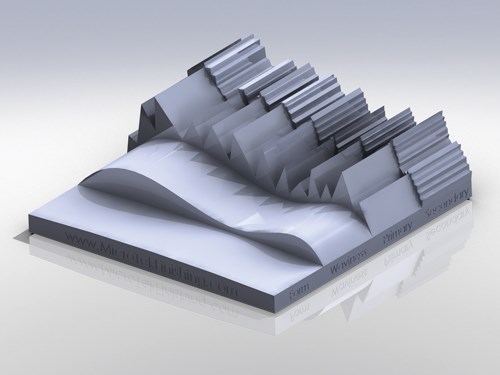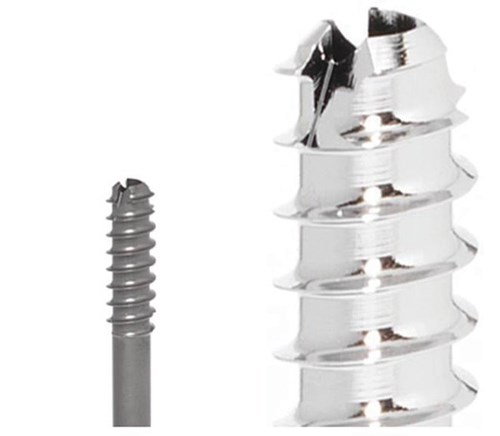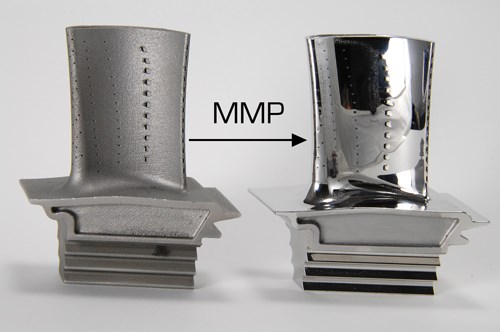Cutting a Micron at a Time
When the task is to remove very small amounts of material, this process may be the answer.
Wendell Morris doesn’t wear a cape, nor can he leap buildings in a single bound.
But what his company, MicroTek Finishing, can do is produce a “super finish” using high-precision tools and technologies that smoothes a surface—or even intentionally leaves specific controlled amounts of roughness behind—unlike any other surface treatment on the market.
MicroTek, based in Cincinnati, Ohio, is the North American licensee for Swiss company BESTinCLASS’s proprietary deburring and polishing method known as the Micro Machining Process (MMP), a physical-catalyst surface treatment applied to items placed inside a treatment tank that mechanically removes only microns of material.
It’s a process that made its debut in the U.S. less than 3 years ago, but it is showing remarkable promise to what is currently a small niche of applications—the biggest of which is in the medical industry—and has tremendous upside to other markets such as aerospace, gears, tool and die, and luxury goods.
“MMP can provide highly accurate, selective removal of surface roughness,” says Mr. Morris, president of MicroTek and also a partner in Morris Technologies Inc., an additive metal manufacturing company. “No one else can do what we are doing,” he says.
Selectively Remove Roughness
Being able to selectively remove roughness from a surface, especially components used in medical devices and implants, has new meaning when MicroTek and its engineers get their hands on a part. Using a proprietary process, they are able to “map” various levels of roughness found on surfaces after the initial machining is completed and the parts are handed over to them.
Mr. Morris says the process is broadly compatible with all of the materials and coatings commonly used in medical applications, adding that while other finishing technologies may struggle with low Ra values on materials such as titanium, MMP can routinely reach values of
4 microinches or less.
The process starts with using a profilometer to perform a technical verification of the surface and report a roughness profile. Results are displayed as “frequency range” waves on a graph showing amplitude, or size of surface irregularity, versus position.
MicroTek classifies the roughness into four components: the outermost, secondary micro roughness; the primary micro roughness; waviness; and form.
1.
The highest frequency is termed “secondary micro roughness,” which comes from the roughness of the cutting tool’s surface that is transferred to the part during manufacturing.
2.
The next highest frequency range is “primary micro roughness,” which comes from the rotation of the cutting tool.
3.
The next frequency range is “waviness” from built-in operating tolerances of the manufacturing machine itself.
4.
The lowest frequency range is considered the basic form, or the pure shape the designer intends, without roughness.
Micro Milling-Type Cutters
After reviewing customer specifications, the finishing process begins with parts being placed in the MMP envelope or “vat,” where hundreds of thousands of micromilling-type cutters begin taking off anywhere from less than a micron to 20 microns of material. Special “micro tools” target each frequency range of surface roughness, with the secondary micro roughness (the highest frequency range) getting worked on first.
Tim Bell, MicroTek’s V.P. of development, says that when the first set of roughness is eliminated, another set of tools works on each level successively until reaching a now-highly polished, pure form.
“It’s technology that completely replaces several steps in finishing parts,” he says. “It keeps geometries intact, including small features and sharp edges, and replaces the hand polishing of parts such as orthopedic implants.”
Mr. Morris says the mechanical component of MMP is based on high-energy movements that produce a flux, which is composed of particles aggregated “in situ” by the catalyst. The physical-catalyst component of MMP comes from specific aggregates whose surfaces are engineered to match the level of roughness that will be removed from the part being treated.
Swiss Technology
The microcutters, which are manufactured by BESTinCLASS, have a microtool and a nanotool component that are both added to the vat and, with the help of a catalyst, they combine to form the actual cutting tools.
Much of what occurs in the actual finishing process is highly proprietary, therefore neither BESTinCLASS nor MicroTek are willing to share those details.
But Mr. Bell describes the process as the tools surrounding the parts so they work homogeneously across the part surfaces—“skating” along all the surfaces, as he calls it. The cutting tools will polish off roughness by removing material, usually 5 to 10 microns, but Mr. Bell says the removal takes place only where the roughness frequency matches the range that the tools were designed for and not just the tops of the peaks like traditional abrasive polishing processes.
“The tools are engineered to work only until they remove their particular frequency range, so once those frequencies are no longer on the parts, the tools effectively ‘turn off’ because there’s nothing left that matches the frequencies they can cut,” he says.
Mr. Morris says traditional surface finishing options are sometimes limited in their capability to handle complex geometries without altering the geometry itself, because they are removing material from the surface in a relatively uncontrolled manner.
Maintaining Sharp Edges
“Polishing surfaces on complex geometries generally meant rounding sharp edges, obliterating fine details and subtly altering the actual shape,” Mr. Morris continues. “It’s a degree of precision that is unique in the market and a process that gives us the ability to meet customers’ exact specifications in a repeatable fashion.”
The medical device and implant industry is paying very close attention to what MicroTek is saying about the way they are finishing parts to such a degree that has not been seen—or unseen—before. The aerospace sector has also sat up and taken notice of the advanced technology.
“The medical and aerospace industries are two of the most risk-averse sectors out there,” Mr. Morris says. “They will spend years making sure any change they make is the right change. The sales cycle is a bit slower in those regards, but we are making great progress in educating the industry on what we have to offer them.”
The upside is tremendous from almost all views. Mr. Morris tells his customers there is practically no concern about altering the mechanical properties of parts through MMP. He says the process doesn’t use high or low temperatures, acid attack or electrical current, and there is no surface contamination of parts, which again makes MMP ideal for medical applications.
The process was developed in 2002 by BESTinCLASS. Several years later, Compagnie Financière Richemont SA, the Swiss parent company of many prestigious luxury brands, including Cartier, Van Cleef & Arpels, Baume & Mercier, and Montblanc, realized the value MMP brought to the luxury goods manufacturing process, and the company then acquired BESTinCLASS.
China, U.K. and the U.S.A.
In 2008, BESTinCLASS began looking at international
expansion of the MMP technology by signing joint-venture agreements with companies in China and the U.K.,
and that’s also when Morris Technologies began talking
to the company about using the technology in its additive metal manufacturing company.
“We first started the development of this process in the watch industry, for wristwatch bracelet links,” says Frederic Bajard, chief operating officer at BESTinCLASS. “However, at the time, our methods of production did not allow us to provide our customers with sufficiently competitive prices. But we have optimized our processes, and thus have reached very attractive levels of competitiveness.”
Mr. Morris adds that, in some cases, the MMP may cost more per part to finish, but the reduction in part rejects because its finishing precision will often result in a lower total cost.
“When we can show a customer that there will eventually be a lower scrap rate, then I know our total costs will be the same—if not lower—than what they are currently experiencing,” he says. “Anytime you can demonstrate a more consistent, repeatable finish that is completely homogenized, then that is something that may bring considerable value to a customer.”
Increasingly, machining on the micro and nano level is pushing the boundaries of traditional metalcutting processes. The MicroTek system may be a means of pushing the envelope for even finer customer demands that might have been a no-quote in the past.
For more information on MicroTek Finishing, please call 513-766-5600 or visit MicroTekFinishing.com.
Related Content
JR Machine Launches Expansion Strategy, Hires New CEO
An investment from Schneider Resources Holding positions JR Machine to grow in emerging markets such space exploration and green energy.
Read MoreT.J. Davies Retention Knobs Harden Over Time
Each retention knob is magnetic particle tested and pull tested to 2.5X the pulling force of the drawbar it is designed for.
Read MoreThe Value of Mass Finishing, Shot Blasting for Aerospace and Medical Applications
The choice between mass finishing and shot blasting for CNC-machined parts depends on the specific requirements of the application.
Read MoreSandvik Coromant Inserts Provide Stable Turning of Aerospace Components
The new insert grades GC1205 and GC1210 cover a large application area within last-stage machining and intermediate-stage machining when turning aerospace engine components.
Read MoreRead Next
5 Aspects of PMTS I Appreciate
The three-day edition of the 2025 Precision Machining Technology Show kicks off at the start of April. I’ll be there, and here are some reasons why.
Read MoreEmerging Leaders Nominations Now Open
Here’s your chance to highlight a young person in your manufacturing business who is on the path to be a future leader moving your company forward.
Read MoreA Tooling Workshop Worth a Visit
Marubeni Citizen-Cincom’s tooling and accessory workshop offers a chance to learn more about ancillary devices that can boost machining efficiency and capability.
Read More









.png;maxWidth=300;quality=90)














